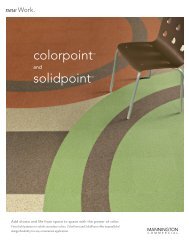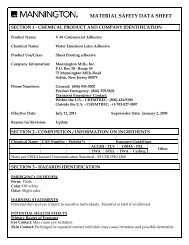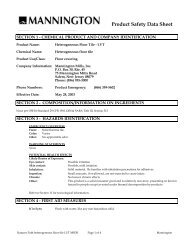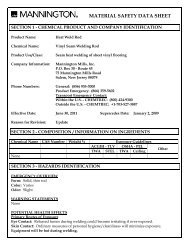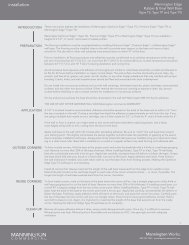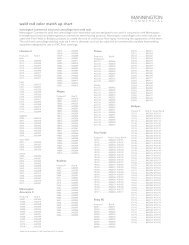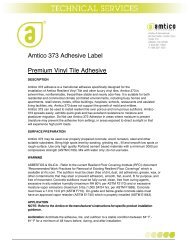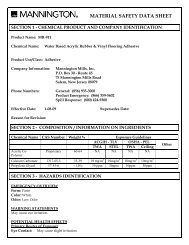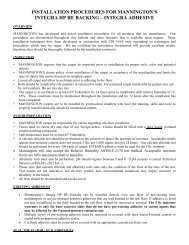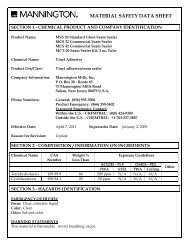MSDS Seam Coater Pen - Mannington
MSDS Seam Coater Pen - Mannington
MSDS Seam Coater Pen - Mannington
Create successful ePaper yourself
Turn your PDF publications into a flip-book with our unique Google optimized e-Paper software.
MATERIAL SAFETY DATA SHEETSECTION 1 - CHEMICAL PRODUCT AND COMPANY IDENTIFICATIONProduct Name:Chemical Name:Product Use/Class:Company Information:<strong>Mannington</strong> Commercial Quantum Guard HP <strong>Seam</strong> Coating MarkerAcrylic SealerClear Finish Marker<strong>Mannington</strong> Mills, Inc.P.O. Box 30 - Route 4575 <strong>Mannington</strong> Mills RoadSalem, New Jersey 08079 U.S.A.Phone Numbers: General: (856) 935-3000Product Emergency: (866) 359-5602Transport Emergency Contact:Within the U.S. - CHEMTREC: (800) 424-9300Outside the U.S. - CHEMTREC: +1-703-527-3887Effective Date: June 1, 2011 Supercedes Date: N/AReason for Revision:NewSECTION 2 - COMPOSITION / INFORMATION ON INGREDIENTSChemical Name CAS Number Weight % Exposure GuidelinesACGIH - TLV OSHA - PELTWA STEL TWA CeilingWater 7732-18-5 50 - 70Acrylic resin Proprietary < 20Dipropylene 34590-94-8,glycolether 29911-28-2< 20Propylene glycol 57-55-6 < 10Wax & otheradditivesProprietary < 10OtherThis product contains no carcinogens or potential carcinogens as listed by IARC or NTP.SECTION 3 - HAZARDS IDENTIFICATIONEMERGENCY OVERVIEWForm: Liquid that is contained in a marker penColor: Cloudy to slightly translucent liquidOdor: Faint acrylic odor
WARNING STATEMENTSCauses lung, eye and skin irritation.May be harmful if absorbed through skin.Vapor harmful.POTENTIAL HEALTH EFFECTSPrimary Routes of ExposureEye Contact: Product may cause eye irritation; signs and symptoms may include a burningsensation, redness, tearing, inflammation, blurred vision, and/or possible transient corneal injury.Skin Contact: Product may cause skin irritation; signs and symptoms may include drying, cracking,sensitization, reddening, discoloration, blistering and/or swelling.Inhalation: If inhaled, product may cause severe irritation or damage (including but not limited toburns, scarring, and ulcerization) to respiratory tract and central nervous system. Signs andsymptoms may include weakness, headache, drowsiness, dizziness, swelling, abdominal discomfort,burning sensation, shock or collapse, convulsions, breathing difficulties, nasal perforation, ulceration,heart damage, blindness, bleeding and/or death.NOTICE: Reports have associated repeated and prolonged occupational overexposure to solvents,with permanent brain and nervous system damage. Intentional misuse by deliberatelyconcentrating and inhaling the contents of this product may be harmful or fatal.Ingestion: If ingested, product may cause irritation of mouth, throat, stomach, and digestive andcentral nervous systems; signs and symptoms may include headache, drowsiness, dizziness,swelling, abdominal discomfort, and/or burning sensation.Chronic:Other:Refer to Section 11 for toxicological information.SECTION 4 - FIRST AID MEASURESIf in Eyes: If exposure occurs, flush the affected eye for at least 20 minutes. Tilt the head to preventchemical from transferring to the uncontaminated eye. Seek medical attention immediately afterflushing.If on Skin: If exposure occurs, flush the affected area thoroughly with water for at least 15 minutes.Destroy contaminated clothing and shoes. Seek medical attention immediately.If Inhaled: Remove victim to fresh air. If not breathing, administer CPR until help arrives or untilvictim is able to breathe on own. If breathing is difficult, give oxygen. Seek medical attentionimmediately.If Swallowed: Do not induce vomiting. Dilute with water or milk. Never give fluids if the victim isunconscious or having convulsions. Seek medical attention immediately.SECTION 5 - FIRE FIGHTING MEASURESFlash Point: >140 °F.; C.O.C.Lower Explosive Limit (LEL) %: Not knownUpper Explosive Limit (UEL) %: Not knownAuto-Ignition Temperature: Not known2
OSHA Flammability Classification: Not determined.Hazardous Products of Combustion: Combustion may produce carbon monoxide, carbon dioxide,and irritating or toxic vapors and gases.Extinguishing Media: This product is not expected to burn under normal conditions of use.Unusual Fire and Explosion Hazards: Evacuate all persons from the fire area to a safe location. Movenon-burning material, as feasible, to a safe location as soon as possible. Fire fighters should beprotected from potential explosion hazards while extinguishing the fire. Wear self-containedbreathing apparatus (SCBA) and full fire-fighting protective clothing. Thoroughly decontaminate allprotective equipment after use. Containers of this material may build up pressure if exposed to heat(fire). Use water spray to cool fire-exposed containers. Use water spray to disperse vapors if a spill orleak has not ignited. DO NOT extinguish a fire resulting from the flow of flammable liquid until theflow of the liquid is effectively shut off. This precaution will help prevent the accumulation of anexplosive vapor-air mixture after the initial fire is extinguished.Fire Fighting Equipment:Miscellaneous Advice:Refer to Section 10 for additional information.SECTION 6 - ACCIDENTAL RELEASE MEASURESPersonal Precautions:Methods for Clean-up: Follow personal protective equipment recommendations found in Section 8.Personal protection needs must be evaluated based on information provided on this sheet and thespecial circumstances created by the spill, including the material spilled, the quantity of the spill, thearea in which the spill occurred, and the training and the expertise of employees in the arearesponding to the spill. Never exceed any occupational exposure limits. Shut off ignition sources;including electrical equipment and flames. Do not allow smoking in the area. Do not allow the spilledproduct to enter public drainage systems or open waterways.Refer to Section 13 for disposal information.Refer to Sections 14 and 15 for reportable quantity information.SECTION 7 - HANDLING AND STORAGEHandling: It is good practice to avoid contact with the product and/or its vapor, mists or dust byusing appropriate protective measures. Wash thoroughly after handling and before eating ordrinking. Empty containers (marking pens) may retain product residue or vapor. Do not pressurize,cut, or expose container to heat or other sources of ignition.Storage: Keep containers (marker pens) closed when not in use. Store in cool well ventilated space.Consult the <strong>Mannington</strong> Professional Installation Handbook or the <strong>Mannington</strong> website atwww.mannington.com for additional information on handling and storage.SECTION 8 - EXPOSURE CONTROLS / PERSONAL PROTECTIONEngineering Controls: Use adequate ventilation to maintain airborne concentrations at levels belowpermissible or recommended occupational exposure limits.3
Respiratory Protection: Not normally required; but if certain circumstances would arise wherepermissible exposure limits might be exceeded, use an air-purifying respirator with the appropriatecartridge, while using the product.Eye Protection: Wear chemical-resistant glasses and/or goggles when eye and face contact arepossible due to splashing or spraying of material.Hand and Skin Protection: Wear chemical-resistant gloves if concerned with pen leakage oranticipated contact with the liquid material.Other Protective Equipment:Hygienic Practices: Always wash hands before eating, smoking or using toilet facilities. Do notsmoke in any chemical handling or storage area. Food or beverages should not be consumedanywhere this product is handled or stored. Wash thoroughly after handling.SECTION 9 - PHYSICAL AND CHEMICAL PROPERTIESAppearance: Cloudy or slightly translucent liquid Water Solubility: MisciblePhysical State: Liquid Volatiles (Wt. %): Nom. 73 %Melting Point: Not determined Volatiles (g/l): 246.4Boiling Point: Not determinedVapor Pressure: Not determinedDensity:Evaporation Rate: Slower than etherVapor Density: Not determinedpH: Not determinedSpecific Gravity: 1.02 (Water = 1.0) Decomposition Temperature:SECTION 10 - STABILITY AND REACTIVITYConditions to Avoid: Keep away from heat, sparks and flames.Materials to Avoid:Stability: Stable under normal conditions. Contains Non-Photochemically Reactive Solvent.Hazardous Reactions:Hazardous Polymerization: Stable under normal conditions.Hazardous Decomposition Products: Combustion may produce carbon monoxide, carbon dioxide,and irritating or toxic vapors and gases.SECTION 11 - TOXICOLOGICAL INFORMATIONProduct LD50 (Oral):Product LD50 (Dermal):Product LC50:Immediate (Acute) Effects:Delayed (Subchronic & Chronic) Effects:SECTION 12 - ECOLOGICAL INFORMATIONEcological evaluation of this material has not been performed; however, do not allow the product tobe released to the environment.4
SECTION 13 - DISPOSAL CONSIDERATIONSUS EPA RCRA Status:Disposal Considerations: Waste from this material may be a listed and/or characteristic hazardouswaste. Dispose of material, contaminated absorbent, container and unused contents in accordancewith local, state, and federal regulations.Disposal Method:Miscellaneous: Disposal should be done in accordance with all local, state and federal (40 CFR Part261) regulations. Be aware that state and local requirements differ widely depending on location andmay, in many cases be different from federal rules.SECTION 14 - TRANSPORT INFORMATIONThe information provided in this section is for information only. Please apply the appropriateregulations to properly classify your shipment for transport.Per 49 CFR 100-185, this material is not classified as a Hazardous Material and is not regulated.U.S. DOT: Not RegulatedIMDG: Not RegulatedIATA: Follow current IATA regulations and your carrier’s requirements.SECTION 15 - REGULATORY INFORMATIONU.S. Federal Regulations: N.A.SARA Section 313: NoneToxic Substances Control Act: N.A.Inventory Status: N.A.Export Notification: N.A.Other:WARNING: This product contains a chemical known to the state of California to cause cancer andbirth defects, or other reproductive harm.SECTION 16 - OTHER INFORMATIONHazard Ratings Health Fire Reactivity Additional InformationSuggested NFPA Rating 2 1 0Suggested HMIS Rating 2 1 05
Disclaimer:Although the information and recommendations set forth herein (hereinafter "Information") arepresented in good faith and believed to be correct as of the date of hereof, the company makes norepresentations as to the completeness or accuracy thereof. Information is supplied upon thecondition that the persons receiving same will make their own determination as to its suitability fortheir purposes prior to use. In no event will the company be responsible for damages of any naturewhatsoever resulting from the use of or reliance upon Information. NO REPRESENTATIONS ORWARRANTIES, EITHER EXPRESS OR IMPLIED, OF MERCHANTABILITY, FITNESS FOR APARTICULAR PURPOSE OR OF ANY OTHER NATURE ARE MADE HEREUNDER WITHRESPECT TO INFORMATION OR THE PRODUCT TO WHICH INFORMATION REFERS.Legend:N.E. - Not EstablishedS - SkinN.A. - Not Availableppm - Parts per MillionN/A - Not Applicable° F. - Degrees FahrenheitC - Ceiling (Exposure Levels)° C. - Degrees CentigradePEL - Permissible Exposure LimitsSTEL - Short-Term Exposure LimitOEL - Occupational Exposure LimitCIH - Certified Industrial HygienistTSCA - Toxic Substances Control ActTLV - Exposure limits developed by ACCIHNFPA - National Fire Protection AssociationNIOSH - National Institute for Occupational SafetyOSHA- Occupational Safety and Health AdministrationHAZCOM - Hazard Communication Standard (29CFR1910.1200)ACGIH - American Conference of Government Industrial HygienistsMSHA - Mine Safety and Health Adm TWA - Time Weighted AverageCERCLA - Comprehensive Environmental Response, Comprehensive and Liability Act6



